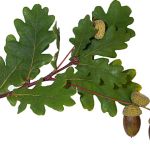| Common Name: |
English Oak |
| Other Names: |
Common Oak, Oak, Oak Bark, Pendunculate Oak, Tanner's Bark |
| Botanical Name: |
Quercus robur |
| Genus: |
Quercus |
| Family: |
Fagaceae |
| Native Location: |
Europe to W Russia |
| Cultivation: |
Deep, well-drained soil in sun or partial shade. Remove lateral branches in late winter to maintain a clean trunk. Foliage may be damaged by mildew, oak phylloxera, chafer beetles, and caterpillars, particularly those of gypsy moths. Gall wasps cause the formation of galls on various parts of the tree, most commonly occuring on the leaves. Trees may be infected by honey fungus and various species of bracket fungus. Oak wilt is a major, usually lethal disease in some areas. |
| Propagation: |
By seed sown when ripe; by grafting in mid-autumn or late winter. |
| Harvest: |
Bark is removed in spring from trees 10-25 years old and dried for use in decoctions and liquid extracts. |
| Variations: |
Atropurpurea
Is slow growing, with red-purple young leaves, which mature to gray-purple.
Height: 10m (30ft)
Width: 10m (30ft) |
Concordia
(Golden Oak)
Is slow growing, and rounded, with golden young foliage that becomes yellow-green in summer.
Originated in Ghent in 1843.
Height: 10m (30ft)
Width: 10m (30ft) |
f. fastigiata
(Cypress Oak)
Is very narrow, with upright branches.
Height: 25m (80ft)
Width: 5m (15ft) |
|
| Height: |
25-35m (80-120ft) |
| Width: |
25m (80ft) |
| Hardiness: |
Z4-10 |
| Parts Used: |
Bark, Leaf, Seed |
| Properties: |
A bitter, astringent, antiseptic herb that reduces inflammation and controls bleeding. |
| Medicinal Uses: |
Internally for diarrhea, dysentery, hemorrhage, and prolapsed uterus or anus. Externally for hemorrhoids, vaginal discharge, sore throat, bleeding gums, minor injuries, dermatitis, weeping eczema, ringworm, ulcers, and varicose veins.
To treat eczema, genital and anal inflammation, gastrointestinal inflammation, diarrhea, cough, varicose veins, and rashes. Germany's Commission E has approved the use of oak to treat diarrhea, inflammation of the mouth and throat, cough, bronchitis, and skin inflammation. |
| Typical Dose: |
A typical internal dose is approximately 1 gm of coarsely powdered bark mixed with 150 ml cold water, boiled for 2 minutes, strained and taken as a tea, up to three times a day. |
| Possible Side Effects: |
Oak's side effects include nausea, vomiting, anorexia, and allergic reactions. |
| Drug Interactions: |
| Taking oak with these drugs may cause or increase kidney damage: |
| Etodolac, (Lodine, Utradol) |
Ibuprofen, (Advil, Motrin) |
Indomethacin, (Indocin, Novo-Methacin) |
Ketoprofen, (Orudis, Rhodis) |
Ketorolac, (Acular, Toradol) |
| Meloxicam, (MOBIC, Mobicox) |
Metformin, (Glucophage, Riomet) |
Methotrexate, (Rheumatrex, Trexall) |
Miglitol, (Glyset) |
Morphine Hydrochloride, (Morphine Hydrochloride) |
| Morphine Sulfate, (Kadian, MS Contin) |
Naproxen, (Aleve, Naprosyn) |
Nitrofurantoin, (Furadantin, Macrobid) |
Ofloxacin, (Floxin, Ocuflox) |
Penicillin, (Pfizerpen, Wycillin) |
| Piroxicam, (Feldene, Nu-Pirox) |
Propoxyphene, (Darvon, Darvon-N) |
Rifampin, (Rifadin, Rimactane) |
Stavudine, (Zerit) |
Sucralfate, (Carafate, Sulcrate) |
| Tramadol, (Ultram) |
Valacyclovir, (Valtrex) |
Valganciclovir, (Valcyte) |
Vancomycin, (Vancocin) |
Zidovudine, (Novo-AZT, Retrovir) |
| Taking oak with these drugs may interfere with the absorption of the drug: |
| Ferric Gluconate, (Ferrlecit) |
Ferrous Fumarate, (Femiron, Feostat) |
Ferrous Gluconate, (Fergon, Novo-Ferrogluc) |
| Ferrous Sulfate, (Feratab, Fer-Iron) |
Ferrous Sulfate and Ascorbic Acid, (FeroGrad 500, Vitelle Irospan) |
Iron-Dextran Complex, (Dexferrum, INFeD) |
| Morphine Hydrochloride, (Morphine Hydrochloride) |
Morphine Sulfate, (Kadian, MS Contin) |
Polysaccharide-Iron Complex, (Hytinic, Niferex) |
|
| Supplement Interactions: |
- The tannins in oak may cause the alkaloids in certain other herbs to separate and settle, increasing the risk of toxic reactions.
- May cause the separation and settling out of iron salts when taken with Iron supplements.
|
| Culinary Uses: |
Acorns can be ground into flour and roasted as a coffee substitute. |
| Economic Uses: |
Wood is traditionally used for making oak barrels that give a distinctive flavor to wine. Bark and galls are used in tanning and also in dyeing, the color produced being dependent on the mordant. |
| Warning: |
Not taken longer than four weeks at a time |
| Bibliography: |
Encyclopedia of Herbs by Deni Brown Copyright © 1995, 2001 Dorling Kindersley Limited Pg 339
The Essential Herb-Drug-Vitamin Interaction Guide by Geo. T. Grossberg,MD and Barry Fox,PhD Copyright©2007 Barry Fox,PhD. Pp.352-353 |
